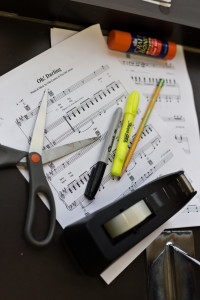Blog

25
Oct
Tools of the Trade
by
Lyn Koenning
on October 25, 2015
0
comments
We’ve already covered how to get the right songs in your book and how to make the right cuts in your songs; If you missed them, read The First 5 Songs to Put in Your Audition Book NOW and Don’t Make This Mistake When Cutting Your Audition Songs. Now let’s talk about how to deliver the right information in your sheet music.

Your audition accompanist wants to do a great job as your musical collaborator, but let’s consider some of the challenges they have to overcome along the way:
- They’re sight-reading your music. Even if it’s a familiar song, yours might be in a different key or a different arrangement than they’re used to playing.
- Between all the notes, musical markings, dynamics, and lyrics, there’s a lot of information to process —and it all has to come together with no rehearsal.
- Page turns are basically an unavoidable part of the job, but realize that every time they have to turn a page, the accompanist must take a hand off the piano, turn the page, find their place and get back on track.
So let’s answer some questions that can help with these issues:
- What musical information will quickly form a musical bond between you and the pianist?
- What’s helpful?
- What’s distracting?
- The easier you make it for the accompanist to follow the musical flow and information on your sheet music, the more likely it is that they can be a great musical collaborator.
- Your sheet music can help your audition or it can hurt it. A few basics:
- Reduce to 93% on a copy machine if the original comes from a large book; you need the entire piano part to be visible.
- If using a printer, use high quality settings so that all the music staff lines and notes print clearly (and always have a backup ink cartridge on hand).
- To minimize page turns —
- make double-sided copies unless your cut is 3 pages or less
- remove any pages that aren’t used in the cut
- Put the music in a nice, black three-ring binder.
- A big part of your success in quickly getting your performance to “gel” with a pianist will be about rhythm — clearly communicating tempo and groove (or “feel”) and addressing anything that changes the flow of the rhythmic pulse during your audition cut. So you’ll want to be sure there is a tempo mark or description of the feel at the beginning of the cut, and you’ll want to highlight any places in the cut where that pulse slows down, speeds up, stretches, pauses, holds, or stops. Look for and highlight words and symbols in your sheet music like fermatas, rit., accel., full stops (“railroad tracks”), colla voce, etc.
- If your cut doesn’t begin on the first page of the sheet music, write the title of the song and, if applicable, what musical it’s from across the top.
- Clearly mark the start and end.
- Mark each section of unused measures with one simple “X”
- Close off a section just before an “X” with a highlighted, backward-facing bracket.
- When jumping across an “X”, mark the beginning of the next section with a highlighted, forward-facing bracket.
- If your cut involves a D.S. or repeat, copy the material again and keep the flow of the sheet music moving forward; don’t make the accompanist turn back and search for a D.S. or repeat sign!
- Beyond the basics:
- Neatness counts. Use a good quality soft lead pencil or fine tip marker to make your brackets and write in any specific musical or tempo markings. If using a sharpie marker, make sure it doesn’t bleed to the other side of the page.
- Use legible, neat handwriting that communicates professionalism.
- The sheet music must be in the correct key for your voice. Asking an accompanist to transpose on sight will not provide the kind of musical support you need in an audition.
- Match the lyrics in the sheet music with the ones you’re singing. For example, if you’re singing lyrics from one verse but using the music from another, use “whiteout” tape to cover up the incorrect lyrics, then neatly write in the ones you’re using. This helps the accompanist know that they’re in the right place.
- If your vocal melody is doubled in the piano accompaniment, suggest to the accompanist that they don’t need to play that along with you. This gives you more freedom in your singing and allows the accompanist to focus on playing the supporting music rather than the melody.
- Avoid micromanaging the musical interpretation. Rather than using an excessive (and potentially distracting) amount of articulations and dynamics, include only what’s needed for the accompanist to provide a solid musical interpretation. Give enough information to be helpful but not so much as to be overwhelming.
So you’ve got a good cut that’s neat and clearly marked. Now write out a script that explains the cut to the accompanist in about 15 seconds. Practice talking through the cut and pointing out the highlighted sections in your sheet music until it feels comfortable.
Question: What are some other ways to engage the accompanist as your musical collaborator?
Share your ideas in the comments below or on the AuditionCutPro Facebook page. And if you’d rather spend your time polishing your performance instead of cutting and marking songs, visit the AuditionCutPro Store to purchase our professionally-cut, arranged, and recorded audition cuts.
